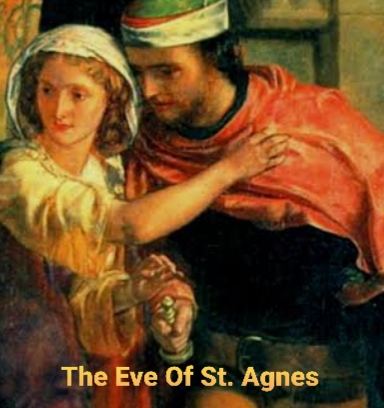Critical Appreciation of The Eve Of St.Agnes
The Eve of St.Agnes is a beautiful romantic creation of John Keats. This poem was written in 1819 and was published in 1820. He was died at the age of 26 years. His father left him when he was only 8 years. His miseries of life taught him a great lesson and that lesson brought him at the highest point of literary world in very short journey of physical existence in the world. He wrote many poems by the core of his heart. His first long poem appeared in 1818. The poem Endymion begins with the famous line;A thing of beauty is a joy forever. This poem is taken as one of the finest and the most significant works in early 19th century. This poem is written in Spenserian stanzas;eight lines in iambic pentameter followed by a single line in iambic hexameter.St. Agnes’s eve is the evening before the day on which the memory of St. Agnes is celebrated. The eve of St. Agnes is 20th January and 21st of January. The eve is called the vigil and the day is called the feast. So,The St. Agnes eve is January 20th and I am exploring that St Agnes was a young Roman girl who converted to Christianity and who was persecuted and finally she suffered death for her faith under the emperor Diocletian. She was subsequently canonized and declared a saint by the church and a day was devoted to her memory for virginity.
The setting of the poem is a medieval castle, the time is cold of December and January, the eve of the Feast of St. Agnes. Madeline is assured that if she keeps fast and performs some special rites,she will have a clear vision of her lover at midnight. She is impatiently waiting for the midnight to fall and goes to bed without supper as a custom. On this same evening, Porphyro who is the lover of Madeline, comes to her castle without any notice. Porphyro is considered as the enemy by Madeline’s family and they want to kill him on the first sight. Luckily he meets Madeline’s old nurse, Angela who is the friend to Porphyro. She tells him the plan of Madeline and her belief on the ritual. He suddenly thinks of making Madeline’s dream a real by his presence in her bedroom at midnight. He requests Angela to help her and also makes her believe that he will do no harm to her anyhow. Then she leads him to Madeline’s chamber and hides him in a closet. Madeline in a beautiful thought of her lover to come in the dream enters her room and falls asleep with fragrance. Supposedly, her fast and the ritual brought positive result. Her sleep becomes the sleep of enchantment and her lover Porphyro comes in her dream as if immortalized. After she falls asleep, he comes closer to her and awakens her by playing a flute. When her eyes opened she was still in the grip of the magic spell of the wonderful dream. She lost the pleasure of her dream and she found Porphyro in his ordinary form not in the immortal form like in the dream. She was so enchanted with the day visionary Porphyro that she wanted him back. And her wish is granted publicly. They got mystic marriage. The spell of the magic of the night came to an end. But, Madeline feared that he would leave her all alone. To make her sure, he urged with a sultry voice to her to run away with him from the castle. Finally,they run away from the castle without anyone’s notice.In The Eve of St. Agnes, John Keats is not interested in the story or in the characters but in the romantic love and its celebration echoed in the surroundings. For him, romantic love is a heavenly experience and to give his romantic lovers this beautiful and enchanting experience,he puts them under the spell of magic.This narrative poem is full of magic and supernatural elements which is one of the main features of romanticism.
This poem is descriptive in nature like a painting where every minute is vividly presented in figure.The scene in the chamber is so beautifully explained that one can make the scene in his mind and feel the innate sensuousness of the poet.
Every minute gives a special contribution to praise the romantic love in the poem with an exceptional attitude. Some critics compared this expression of romantic love of Keats’s love affair with Fanny Brawne. The contrast in The Eve of St. Agnes by John Keats is one of the dominant artistic devices used in the poem. The deliberate use of bitter cold contrasts with the warm love of Madeline and Porphyro and The love of Madeline and Porphyro is foregrounded against the hatred of Madeline’s family for Porphyro. Although, all the senses are enticed by the poet, the sense of love sight is mainly attracted in the poem.The description of the stained window glass in the chamber of Madeline, that is the most beautiful example of his influential appealing power to the sight. This window is "diamonded with panes of quaint device, / Innumerable of stains and splendid dyes." Madeline is transformed into " An Angel" by the stained glass as the moonlight comes through it. Finally, The death of Angela and the Beadsman at the end of the poem show his abrupt and unfinished ending of the poem.The poem gives a multitude of serious thoughts. His poetic terms are very important to understand Keats inner ideas. https://youtu.be/9tECHgBbTP4




https://youtu.be/9tECHgBbTP4
ReplyDeleteThis YouTube channel is useful for Grammatical Knowledge
mast
Delete